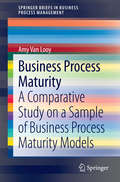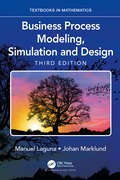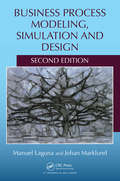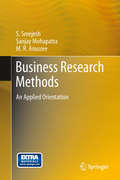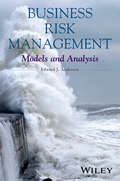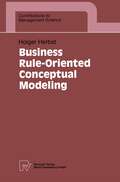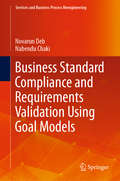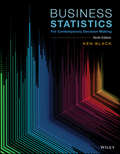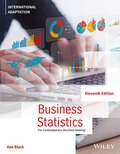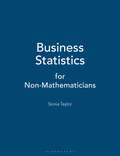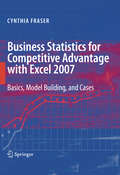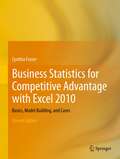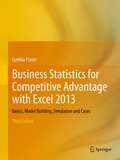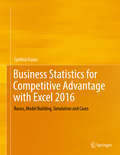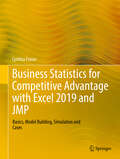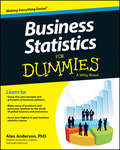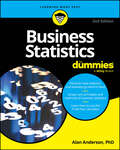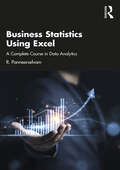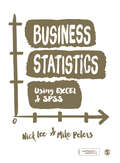- Table View
- List View
Business Process Maturity: A Comparative Study on a Sample of Business Process Maturity Models (SpringerBriefs in Business Process Management)
by Amy Van LooyOrganisations face many challenges, which induce them to perform better, and thus to establish mature (or excellent) business processes. As they now face globalisation, higher competitiveness, demanding customers, growing IT possibilities, compliancy rules etc., business process maturity models (BPMMs) have been introduced to help organisations gradually assess and improve their business processes (e.g. CMMI or OMG-BPMM). In fact, there are now so many BPMMs to choose from that organisations risk selecting one that does not fit their needs or one of substandard quality. This book presents a study that distinguishes process management from process orientation so as to arrive at a common understanding. It also includes a classification study to identify the capability areas and maturity types of 69 existing BPMMs, in order to strengthen the basis of available BPMMs. Lastly it presents a selection study to identify criteria for choosing one BPMM from the broad selection, which produced a free online selection tool, BPMM Smart-Selector.
Business Process Modeling, Simulation and Design (Textbooks in Mathematics)
by Manuel Laguna Johan MarklundBusiness Process Modeling, Simulation and Design, Third Edition provides students with a comprehensive coverage of a range of analytical tools used to model, analyze, understand, and ultimately design business processes. The new edition of this very successful textbook includes a wide range of approaches such as graphical flowcharting tools, cycle time and capacity analyses, queuing models, discrete-event simulation, simulation-optimization, and data mining for process analytics. While most textbooks on business process management either focus on the intricacies of computer simulation or managerial aspects of business processes, this textbook does both. It presents the tools to design business processes and management techniques on operating them efficiently. The book focuses on the use of discrete event simulation as the main tool for analyzing, modeling, and designing effective business processes. The integration of graphic user-friendly simulation software enables a systematic approach to create optimal designs.
Business Process Modeling, Simulation and Design
by Manuel Laguna Johan MarklundMost textbooks on business process management focus on either the nuts and bolts of computer simulation or the managerial aspects of business processes. Covering both technical and managerial aspects of business process management, Business Process Modeling, Simulation and Design, Second Edition presents the tools to design effective business proce
Business Process Modeling, Simulation and Design (Textbooks in Mathematics)
by Manuel Laguna Johan MarklundBusiness Process Modeling, Simulation and Design, Third Edition provides students with a comprehensive coverage of a range of analytical tools used to model, analyze, understand, and ultimately design business processes. The new edition of this very successful textbook includes a wide range of approaches such as graphical flowcharting tools, cycle time and capacity analyses, queuing models, discrete-event simulation, simulation-optimization, and data mining for process analytics. While most textbooks on business process management either focus on the intricacies of computer simulation or managerial aspects of business processes, this textbook does both. It presents the tools to design business processes and management techniques on operating them efficiently. The book focuses on the use of discrete event simulation as the main tool for analyzing, modeling, and designing effective business processes. The integration of graphic user-friendly simulation software enables a systematic approach to create optimal designs.
Business Research Methods: An Applied Orientation
by S Sreejesh Sanjay Mohapatra M R AnusreeSince research is best learned by doing, this book emphasizes a hands-on, do-it yourself approach. The readers have many opportunities to see how business researches affect and support management decision. The book used a case study approach for all the chapters with interactive videos. The book gave emphasis to quantitative data analysis using a software program, IBM SPSS 20.0. The data analysis chapters illustrate in detail each step in running the software programs. The software programs files are provided for all data sets: outputs, demonstration movies, and screen captures are on the Website. This book provides students most extensive help available to learn quantitative data analysis using SPSS. Thus, the authors prepared this textbook and all the additional materials to help the students to understand the functional principles of business research and how to apply them in real-life situations.
Business Risk Management: Models and Analysis
by Edward J. AndersonA comprehensive and accessible introduction to modern quantitative risk management. The business world is rife with risk and uncertainty, and risk management is a vitally important topic for managers. The best way to achieve a clear understanding of risk is to use quantitative tools and probability models. Written for students, this book has a quantitative emphasis but is accessible to those without a strong mathematical background. Business Risk Management: Models and Analysis Discusses novel modern approaches to risk management Introduces advanced topics in an accessible manner Includes motivating worked examples and exercises (including selected solutions) Is written with the student in mind, and does not assume advanced mathematics Is suitable for self-study by the manager who wishes to better understand this important field. Aimed at postgraduate students, this book is also suitable for senior undergraduates, MBA students, and all those who have a general interest in business risk.
Business Risk Management: Models and Analysis
by Edward J. AndersonA comprehensive and accessible introduction to modern quantitative risk management. The business world is rife with risk and uncertainty, and risk management is a vitally important topic for managers. The best way to achieve a clear understanding of risk is to use quantitative tools and probability models. Written for students, this book has a quantitative emphasis but is accessible to those without a strong mathematical background. Business Risk Management: Models and Analysis Discusses novel modern approaches to risk management Introduces advanced topics in an accessible manner Includes motivating worked examples and exercises (including selected solutions) Is written with the student in mind, and does not assume advanced mathematics Is suitable for self-study by the manager who wishes to better understand this important field. Aimed at postgraduate students, this book is also suitable for senior undergraduates, MBA students, and all those who have a general interest in business risk.
Business Rule-Oriented Conceptual Modeling (Contributions to Management Science)
by Holger HerbstThis book is based on a PhD dissertation which was accepted by the faculty of Law and Economics at the University of Bern, Switzerland. The ideas presented were partially developed in a research project founded by the Swiss National Sci ence Foundation in 1993 and 1994. This research project was concerned with evaluating the application of database triggers and active databases for the im plementation of business rules. We recognized among other things the lack of a methodology for modeling such business rules on the conceptual level. Therefore, this became the focus of the follow-up research which resulted in this book. All this work would not have been possible without the help of several people. First of all, I would like to give special thanks to my thesis supervisor Prof. Dr. Gerhard Knolmayer. He not only initiated the research project and found an in dustry partner, but also provided very valuable ideas, and critically reviewed and discussed the resulting publications. Furthermore, I would like to express my thanks to the second thesis supervisor Prof. Dr. Sham Navathe from Georgia In stitute of Technology who influenced my work with results from a former re search project and who agreed to evaluate the resulting PhD Dissertation.
Business Standard Compliance and Requirements Validation Using Goal Models (Services and Business Process Reengineering)
by Novarun Deb Nabendu ChakiThis book discusses enterprise hierarchies, which view a target system with varying degrees of abstraction. These requirement refinement hierarchies can be represented by goal models. It is important to verify that such hierarchies capture the same set of rationales and intentions and are in mutual agreement with the requirements of the system being designed. The book also explores how hierarchies manifest themselves in the real world by undertaking a data mining exercise and observing the interactions within an enterprise. The inherent sequence-agnostic property of goal models prevents requirement analysts from performing compliance checks in this phase as compliance rules are generally embedded with temporal information. The studies discussed here seek to extract finite state models corresponding to goal models with the help of model transformation. The i*ToNuSMV tool implements one such algorithm to perform model checking on i* models. In turn, the AFSR framework provides a new goal model nomenclature that associates semantics with individual goals. It also provides a reconciliation machinery that detects entailment or consistency conflicts within goal models and suggests corrective measures to resolve such conflicts. The authors also discuss how the goal maintenance problem can be mapped to the state-space search problem, and how A* search can be used to identify an optimal goal model configuration that is free from all conflicts. In conclusion, the authors discuss how the proposed research frameworks can be extended and applied in new research directions. The GRL2APK framework presents an initiative to develop mobile applications from goal models using reusable code component repositories.
Business Statistics: For Contemporary Decision Making
by Ken BlackBusiness Statistics: For Contemporary Decision Making, 9th Edition continues the tradition of presenting and explaining the wonders of business statistics through the use of clear, complete, student-friendly pedagogy. Ken Black's text equips readers with the quantitative decision-making skills and analysis techniques they need to make smart decisions based on real-world data.
Business Statistics: For Contemporary Decision Making, International Adaptation
by null Ken BlackBusiness Statistics uses current real-world data to equip students with the business analytics techniques and quantitative decision-making skills required to make more thoughtful, information-based decisions in today's workplace. Helping the student understand business analytics and the role that business statistics plays in it, the book has infused the language of business analytics along with its definitions, approaches, and explanations throughout the text. Continuing the tradition of presenting and explaining business statistics using clear, complete, and student-friendly pedagogy, this international edition includes new chapter cases reinforcing the vibrancy and relevance of statistics. In addition, topical changes have been made in select chapters and problems have been revised in all the chapters.
Business Statistics: for Non-Mathematicians
by Sonia TaylorBusiness Statistics is a student-friendly book written to encourage first year business students to understand (and enjoy!) their first experience of statistics. Each topic is well illustrated, with worked examples, tutorial sheets, supplementary exercises, and computer worksheets in SPSS, Minitab and Excel - all with answers provided.
Business Statistics for Competitive Advantage with Excel 2007: Basics, Model Building and Cases
by Cynthia FraserExceptional managers know that they can create competitive advantages by basing decisions on performance response under alternative scenarios. To create these advantages, managers need to understand how to use statistics to provide information on performance response under alternative scenarios. Statistics are created to make better decisions. Statistics are essential and relevant. Statistics must be easily and quickly produced using widely available software, Excel. Then results must be translated into general business language and illustrated with compelling graphics to make them understandable and usable by decision makers. This book helps students master this process of using statistics to create competitive advantages as decision makers. Statistics are essential, relevant, easy to produce, easy to understand, valuable, and fun, when used to create competitive advantage. The Examples, Assignments, And Cases Used To Illustrate Statistics For Decision Making Come From Business Problems McIntire Corporate Sponsors and Partners, such as Rolls-Royce, Procter & Gamble, and Dell, and the industries that they do business in, provide many realistic examples. The book also features a number of examples of global business problems, including those from important emerging markets in China and India. It is exciting to see how statistics are used to improve decision making in real and important business decisions. This makes it easy to see how statistics can be used to create competitive advantages in similar applications in internships and careers. Learning Is Hands On With Excel and Shortcuts
Business Statistics for Competitive Advantage with Excel 2010: Basics, Model Building, and Cases
by Cynthia FraserExceptional managers know that they can create competitive advantages by basing decisions on performance response under alternative scenarios. To create these advantages, managers need to understand how to use statistics to provide information on performance response under alternative scenarios. This updated edition of the popular text helps business students develop competitive advantages for use in their future careers as decision makers. Students learn to build models using logic and experience, produce statistics using Excel 2010 with shortcuts, and translate results into implications for decision makers. The author emphasizes communicating results effectively in plain English and with compelling graphics in the form of memos and PowerPoints.Statistics, from basics to sophisticated models, are illustrated with examples using real data such as students will encounter in their roles as managers. A number of examples focus on business in emerging global markets with particular emphasis on China and India. Results are linked to implications for decision making with sensitivity analyses to illustrate how alternate scenarios can be compared. Chapters include screenshots to make it easy to conduct analyses in Excel 2010 with time-saving shortcuts expected in the business world. PivotTables and PivotCharts, used frequently in businesses, are introduced from the start. Monte Carlo simulation is introduced early, as a tool to illustrate the range of possible outcomes from decision makers’ assumptions and underlying uncertainties. Model building with regression is presented as a process, adding levels of sophistication, with chapters on multicollinearity and remedies, forecasting and model validation, autocorrelation and remedies, indicator variables to represent segment differences, and seasonality, structural shifts or shocks in time series models. Special applications in market segmentation and portfolio analysis are offered, and an introduction to conjoint analysis is included. Nonlinear models are motivated with arguments of diminishing or increasing marginal response, and a chapter on logit regression models introduces models of market share or proportions. The Second Edition includes more explanation of hypothesis tests and confidence intervals, how t, F, and chi square distributions behave.The Data Files, Solution Files, and Chapter PowerPoints:The data files for text examples, cases, lab problems and assignments are stored on Blackboard and may be accessed using this link:https://blackboard.comm.virginia.edu/webapps/portal/frameset.jspInstructors can gain access to the files, as well as solution files and chapter PowerPoints by registering on the Springer site: http://www.springer.com/statistics/business%2C+economics+%26+finance/book/978-1-4419-9856-9?changeHeader Business people can gain access to the files by emailing the author cfg8q@virginia.edu.https://blackboard.comm.virginia.edu/webapps/portal/frameset.jspInstructors can gain access to the files, as well as solution files and chapter PowerPoints by registering on the Springer site: http://www.springer.com/statistics/business%2C+economics+%26+finance/book/978-1-4419-9856-9?changeHeader Business people can gain access to the files by emailing the author cfg8q@virginia.edu.
Business Statistics for Competitive Advantage with Excel 2013: Basics, Model Building, Simulation and Cases
by Cynthia FraserExceptional managers know that they can create competitive advantages by basing decisions on performance response under alternative scenarios. To create these advantages, managers need to understand how to use statistics to provide information on performance response under alternative scenarios. This updated edition of the popular text helps business students develop competitive advantages for use in their future careers as decision makers. Students learn to build models using logic and experience, produce statistics using Excel 2013 with shortcuts, and translate results into implications for decision makers. The author emphasizes communicating results effectively in plain English and with compelling graphics in the form of memos and PowerPoints. Statistics, from basics to sophisticated models, are illustrated with examples using real data such as students will encounter in their roles as managers. A number of examples focus on business in emerging global markets with particular emphasis on emerging markets in Latin America, China and India. Results are linked to implications for decision making with sensitivity analyses to illustrate how alternate scenarios can be compared. Chapters include screenshots to make it easy to conduct analyses in Excel 2013 with time-saving shortcuts expected in the business world.PivotTables and PivotCharts, used frequently in businesses, are introduced from the start. The Third Edition features Monte Carlo simulation in three chapters, as a tool to illustrate the range of possible outcomes from decision makers’ assumptions and underlying uncertainties. Model building with regression is presented as a process, adding levels of sophistication, with chapters on multicollinearity and remedies, forecasting and model validation, autocorrelation and remedies, indicator variables to represent segment differences, and seasonality, structural shifts or shocks in time series models. Special applications in market segmentation and portfolio analysis are offered, and an introduction to conjoint analysis is included. Nonlinear models are motivated with arguments of diminishing or increasing marginal response.
Business Statistics for Competitive Advantage with Excel 2016: Basics, Model Building, Simulation and Cases
by Cynthia FraserThe revised Fourth Edition of this popular textbook is redesigned with Excel 2016 to encourage business students to develop competitive advantages for use in their future careers as decision makers. Students learn to build models using logic and experience, produce statistics using Excel 2016 with shortcuts, and translate results into implications for decision makers. The textbook features new examples and assignments on global markets, including cases featuring Chipotle and Costco. A number of examples focus on business in emerging global markets with particular emphasis on emerging markets in Latin America, China, and India. Results are linked to implications for decision making with sensitivity analyses to illustrate how alternate scenarios can be compared. The author emphasises communicating results effectively in plain English and with screenshots and compelling graphics in the form of memos and PowerPoints. Chapters include screenshots to make it easy to conduct analyses in Excel 2016. PivotTables and PivotCharts, used frequently in business, are introduced from the start. The Fourth Edition features Monte Carlo simulation in four chapters, as a tool to illustrate the range of possible outcomes from decision makers’ assumptions and underlying uncertainties. Model building with regression is presented as a process, adding levels of sophistication, with chapters on multicollinearity and remedies, forecasting and model validation, auto-correlation and remedies, indicator variables to represent segment differences, and seasonality, structural shifts or shocks in time series models. Special applications in market segmentation and portfolio analysis are offered, and an introduction to conjoint analysis is included. Nonlinear models are motivated with arguments of diminishing or increasing marginal response.
Business Statistics for Competitive Advantage with Excel 2019 and JMP: Basics, Model Building, Simulation and Cases
by Cynthia FraserThe revised Fifth Edition of this popular textbook is redesigned with Excel 2019 and the new inclusion of interactive, user-friendly JMP to encourage business students to develop competitive advantages for use in their future careers. Students learn to build models, produce statistics, and translate results into implications for decision makers. The text features new and updated examples and assignments, and each chapter discusses a focal case from the business world which can be analyzed using the statistical strategies and software provided in the text. Paralleling recent interest in climate change and sustainability, new case studies concentrate on issues such as the impact of drought on business, automobile emissions, and sustainable package goods. The book continues its coverage of inference, Monte Carlo simulation, contingency analysis, and linear and nonlinear regression. A new chapter is dedicated to conjoint analysis design and analysis, including complementary use of regression and JMP.For access to accompanying data sets, please email author Cynthia Fraser at cfg8q@virginia.edu.
Business Statistics For Dummies
by Alan AndersonScore higher in your business statistics course? Easy. Business statistics is a common course for business majors and MBA candidates. It examines common data sets and the proper way to use such information when conducting research and producing informational reports such as profit and loss statements, customer satisfaction surveys, and peer comparisons. Business Statistics For Dummies tracks to a typical business statistics course offered at the undergraduate and graduate levels and provides clear, practical explanations of business statistical ideas, techniques, formulas, and calculations, with lots of examples that shows you how these concepts apply to the world of global business and economics. Shows you how to use statistical data to get an informed and unbiased picture of the market Serves as an excellent supplement to classroom learning Helps you score your highest in your Business Statistics course If you're studying business at the university level or you're a professional looking for a desk reference on this complicated topic, Business Statistics For Dummies has you covered.
Business Statistics For Dummies
by Alan AndersonScore higher in your business statistics course? Easy. Business statistics is a common course for business majors and MBA candidates. It examines common data sets and the proper way to use such information when conducting research and producing informational reports such as profit and loss statements, customer satisfaction surveys, and peer comparisons. Business Statistics For Dummies tracks to a typical business statistics course offered at the undergraduate and graduate levels and provides clear, practical explanations of business statistical ideas, techniques, formulas, and calculations, with lots of examples that shows you how these concepts apply to the world of global business and economics. Shows you how to use statistical data to get an informed and unbiased picture of the market Serves as an excellent supplement to classroom learning Helps you score your highest in your Business Statistics course If you're studying business at the university level or you're a professional looking for a desk reference on this complicated topic, Business Statistics For Dummies has you covered.
Business Statistics For Dummies
by Alan AndersonMake some headway in the notoriously tough subject of business statistics Business Statistics For Dummies helps you understand the core concepts and principles of business statistics, and how they relate to the business world. This book tracks to a typical introductory course offered at the undergraduate, so you know you’ll find all the content you need to pass your class and get your degree. You’ll get an introduction to statistical problems and processes common to the world of global business and economics. Written in clear and simple language, Business Statistics For Dummies gives you an introduction to probability, sampling techniques and distributions, and drawing conclusions from data. You’ll also discover how to use charts and graphs to visualize the most important properties of a data set. Grasp the core concepts, principles, and methods of business statistics Learn tricky concepts with simplified explanations and illustrative graphs See how statistics applies in the real world, thanks to concrete examples Read charts and graphs for a better understanding of how businesses operateBusiness Statistics For Dummies is a lifesaver for students studying business at the college level. This guide is also useful for business professionals looking for a desk reference on this complicated topic.
Business Statistics For Dummies
by Alan AndersonMake some headway in the notoriously tough subject of business statistics Business Statistics For Dummies helps you understand the core concepts and principles of business statistics, and how they relate to the business world. This book tracks to a typical introductory course offered at the undergraduate, so you know you’ll find all the content you need to pass your class and get your degree. You’ll get an introduction to statistical problems and processes common to the world of global business and economics. Written in clear and simple language, Business Statistics For Dummies gives you an introduction to probability, sampling techniques and distributions, and drawing conclusions from data. You’ll also discover how to use charts and graphs to visualize the most important properties of a data set. Grasp the core concepts, principles, and methods of business statistics Learn tricky concepts with simplified explanations and illustrative graphs See how statistics applies in the real world, thanks to concrete examples Read charts and graphs for a better understanding of how businesses operateBusiness Statistics For Dummies is a lifesaver for students studying business at the college level. This guide is also useful for business professionals looking for a desk reference on this complicated topic.
Business Statistics Using Excel: A Complete Course in Data Analytics
by R. PanneerselvamThis book gives readers a hands-on understanding of Excel-assisted statistical techniques to take effective business decisions. It showcases applications of the tools and techniques of statistics for analysing business data from the domain of business statistics. The volume provides an exhaustive introduction to the application of statistics in solving business problems and implementing data analytics for effective decision making in all kinds of business situations around the world. With an emphasis on simplicity in presentation of concepts of statistical methods and associated Excel functions, the volume explores the implementation of Excel functions through well-defined sequences of steps. It covers an array of key topics which include Discussions on real-world problems, decision support systems, scope of business statistics, types, and steps of research; Introduction to Excel and its mathematical and preliminary statistical functions; usage of different types of average functions; mean, median, and mode functions; measures of variation; measures of skewness of Excel; In-depth discussions on probability distributions, sampling distributions, testing of hypothesis, chi-square test, non-parametric tests of Excel; Extensive coverage on correlation and covariance, forecasting, analysis of variance, charts in Excel; and Analysis of the concept of linear programming, problem formulations, and techniques of linear programming, followed by the application in Excel. Comprehensive in scope and simple in approach, this book will be key for students and researchers of business studies, business administration, economics, finance, commerce, data analytics/science, and computer science. This will also serve as useful guidebook for business executives and working professionals across the globe.
Business Statistics Using Excel: A Complete Course in Data Analytics
by R. PanneerselvamThis book gives readers a hands-on understanding of Excel-assisted statistical techniques to take effective business decisions. It showcases applications of the tools and techniques of statistics for analysing business data from the domain of business statistics. The volume provides an exhaustive introduction to the application of statistics in solving business problems and implementing data analytics for effective decision making in all kinds of business situations around the world. With an emphasis on simplicity in presentation of concepts of statistical methods and associated Excel functions, the volume explores the implementation of Excel functions through well-defined sequences of steps. It covers an array of key topics which include Discussions on real-world problems, decision support systems, scope of business statistics, types, and steps of research; Introduction to Excel and its mathematical and preliminary statistical functions; usage of different types of average functions; mean, median, and mode functions; measures of variation; measures of skewness of Excel; In-depth discussions on probability distributions, sampling distributions, testing of hypothesis, chi-square test, non-parametric tests of Excel; Extensive coverage on correlation and covariance, forecasting, analysis of variance, charts in Excel; and Analysis of the concept of linear programming, problem formulations, and techniques of linear programming, followed by the application in Excel. Comprehensive in scope and simple in approach, this book will be key for students and researchers of business studies, business administration, economics, finance, commerce, data analytics/science, and computer science. This will also serve as useful guidebook for business executives and working professionals across the globe.
Business Statistics Using EXCEL and SPSS
by Mike Peters Nick Lee'Takes the challenging and makes it understandable. The book contains useful advice on the application of statistics to a variety of contexts and shows how statistics can be used by managers in their work.' - Dr Terri Byers, Assistant Professor, University Of New Brunswick, Canada A book about introductory quantitative analysis, the authors show both how and why quantitative analysis is useful in the context of business and management studies, encouraging readers to not only memorise the content but to apply learning to typical problems. Fully up-to-date with comprehensive coverage of IBM SPSS and Microsoft Excel software, the tailored examples illustrate how the programmes can be used, and include step-by-step figures and tables throughout. A range of ‘real world’ and fictional examples, including "The Ballad of Eddie the Easily Distracted" and "Esha's Story" help bring the study of statistics alive. A number of in-text boxouts can be found throughout the book aimed at readers at varying levels of study and understanding Back to Basics for those struggling to understand, explain concepts in the most basic way possible - often relating to interesting or humorous examples Above and Beyond for those racing ahead and who want to be introduced to more interesting or advanced concepts that are a little bit outside of what they may need to know Think it over get students to stop, engage and reflect upon the different connections between topics A range of online resources including a set of data files and templates for the reader following in-text examples, downloadable worksheets and instructor materials, answers to in-text exercises and video content compliment the book. An ideal resource for undergraduates taking introductory statistics for business, or for anyone daunted by the prospect of tackling quantitative analysis for the first time.
Business Statistics Using EXCEL and SPSS (PDF)
by Mike Peters Nick Lee'Takes the challenging and makes it understandable. The book contains useful advice on the application of statistics to a variety of contexts and shows how statistics can be used by managers in their work.' - Dr Terri Byers, Assistant Professor, University Of New Brunswick, Canada A book about introductory quantitative analysis, the authors show both how and why quantitative analysis is useful in the context of business and management studies, encouraging readers to not only memorise the content but to apply learning to typical problems. Fully up-to-date with comprehensive coverage of IBM SPSS and Microsoft Excel software, the tailored examples illustrate how the programmes can be used, and include step-by-step figures and tables throughout. A range of ‘real world’ and fictional examples, including "The Ballad of Eddie the Easily Distracted" and "Esha's Story" help bring the study of statistics alive. A number of in-text boxouts can be found throughout the book aimed at readers at varying levels of study and understanding Back to Basics for those struggling to understand, explain concepts in the most basic way possible - often relating to interesting or humorous examples Above and Beyond for those racing ahead and who want to be introduced to more interesting or advanced concepts that are a little bit outside of what they may need to know Think it over get students to stop, engage and reflect upon the different connections between topics A range of online resources including a set of data files and templates for the reader following in-text examples, downloadable worksheets and instructor materials, answers to in-text exercises and video content compliment the book. An ideal resource for undergraduates taking introductory statistics for business, or for anyone daunted by the prospect of tackling quantitative analysis for the first time.
